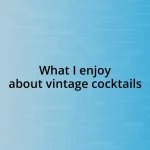Key takeaways:
- Cocktail culture blends artistry, innovation, and community, fostering connections among individuals through shared experiences.
- Key historical milestones include the first cocktail definition in 1806, the influence of Jerry Thomas in the 1800s, creativity during Prohibition, and the rise of classic drinks in the 1950s.
- Key elements of cocktail culture: Craftsmanship (artistry in preparation), Ambience (atmosphere enhancing experience), and Community (social bonds created through shared drink experiences).
- Regional cocktails reflect local ingredients and cultural heritage, demonstrating how drinks can tell stories and connect people to their origins.

Understanding cocktail culture
Cocktail culture is a fascinating blend of artistry, tradition, and social connection. I remember my first experience at a craft cocktail bar; the bartender was like a magician, transforming simple ingredients into something extraordinary. Isn’t it incredible how a well-made drink can spark conversations and forge connections among strangers?
At its core, cocktail culture celebrates creativity and innovation. Have you ever considered how a classic cocktail can evolve into countless variations? That’s the beauty of it! Each twist reflects our personalities and local flavors, turning a simple drink into an expression of individuality.
Moreover, the rituals surrounding cocktail creation and enjoyment offer a sense of community. I’ve often found myself in a vibrant bar, surrounded by laughter and clinking glasses, feeling an unspoken bond with fellow patrons. In these moments, it hits me – cocktail culture isn’t just about the drinks; it’s about celebrating life’s little joys together.

The history of cocktails
The history of cocktails is as rich and colorful as the drinks themselves. I find it fascinating to think back to the early days of cocktail-making, where the bowels of apothecaries served as inspiration, blending herbs, bitters, and spirits for medicinal purposes. This evolution into the world of leisure drinking reveals the cleverness of human creativity – who would have thought that those early experiments would lead to a global culture celebrating spirits?
Here are a few key milestones in cocktail history:
- Early 19th Century: The first definition of a cocktail appeared in an 1806 newspaper, describing a mix of spirits, sugar, water, and bitters.
- Mid-1800s: The publication of Jerry Thomas’s “The Bartender’s Guide” introduced innovative recipes and set the standard for cocktail culture.
- Prohibition Era (1920-1933): This period saw a surge in creativity, as bartenders became masterful at hiding the taste of inferior spirits with fruity mixers.
- Post-War Boom: The 1950s ushered in classic drinks like the Mai Tai and Martini, reflecting a newfound appreciation for leisure and socializing.
For me, the story of cocktails is not just about the drinks but the lifestyle they inspire. I still remember my surprise when I learned about the fascinating origins of the Old Fashioned. It’s a simple drink, yet it carries a legacy that connects generations, reminding me that every sip is a toast to history.

Key elements of cocktail culture
Cocktail culture is intricately woven with various key elements that contribute to its charm and appeal. The concept of craftsmanship stands out for me; every cocktail is like a meticulously crafted piece of art. I still recall a night when a bartender spent what felt like an eternity perfecting a single drink. The dedication to balancing flavors, selecting the right garnishes, and crafting the perfect ice, all while sharing stories about the ingredients, brought the experience to life. It’s moments like these that elevate a simple drink to an unforgettable experience.
An equally important aspect of cocktail culture is the ambience of the venues where these drinks are enjoyed. I’ve walked into dimly lit bars with plush seating and an air of sophistication, and it feels like I’m transported to another time. The atmosphere can influence how a cocktail tastes; sipping a refreshing Mojito on a sun-drenched terrace brings a different kind of joy compared to enjoying the same drink inside a bustling city bar. It’s the setting and the vibe that amplify the enjoyment, allowing us to savor not just the flavors, but the experience itself.
Lastly, community plays a fundamental role in cocktail culture. Many of my fondest memories are tied to gatherings with friends, where we concocted our versions of classic cocktails. The laughter and friendly debates over which recipe was best sparked a deeper connection, reminding me of the simple pleasures of sharing good drinks and stories. As we mix drinks together, we’re blending not just ingredients but also memories—creating our little traditions that bind us closer.
| Key Element | Description |
|---|---|
| Craftsmanship | Attention to detail and artistry involved in cocktail preparation. |
| Ambience | The atmosphere of bars and lounges that enhances the drinking experience. |
| Community | The social connections and shared experiences that cocktails foster. |

Crafting the perfect cocktail
Crafting the perfect cocktail is an art form that requires a balance of creativity and precision. I remember the first time I tried my hand at making a Negroni, an iconic mix of gin, Campari, and vermouth. I was surprised by how the proportions really mattered; one little tweak changed the entire taste profile. It’s moments like that which remind me how each ingredient contributes not just flavor but also a specific character to the drink.
What truly excites me is the impact of fresh ingredients versus their bottled counterparts. The first time I used freshly squeezed lime juice instead of pre-packaged, it felt like opening a window to a world of flavor. The brightness in that cocktail lit up my senses; it’s amazing how such a small change can elevate your drink. Isn’t it intriguing to think about how the simplest ingredients can create a masterpiece in a glass?
Finally, let’s talk about the garnishes. When I think of crafting a cocktail, I always focus on that finishing touch—the garnish. I still giggle at the time I tried to impress a friend with a simple mint sprig, only to realize it was wilting and sad-looking. It taught me that every element counts, and a vibrant garnish can bring a drink to life, both visually and in terms of aroma. It’s those small details that transform a good cocktail into an extraordinary one, isn’t it?

The role of cocktail bars
Cocktail bars serve as vibrant hubs for creativity and connection. I often think back to a little speakeasy I stumbled onto by chance. The moment I walked in, I was met with a mix of laughter, clinking glasses, and the faint sound of jazz—a sensory experience that instantly drew me in. It reminded me that cocktail bars are not just places to grab a drink; they are social spaces where stories unfold, and friendships are forged over beautifully crafted cocktails.
In my experience, the role of cocktail bars goes beyond serving drinks; they curate an experience that highlights the local culture. I remember visiting a bar that featured regional spirits and artisanal mixers, making me feel like I was tasting the essence of the area. With each sip, it was as if the bartender was sharing a piece of their heritage with me. How incredible is it that a drink can bridge the gap between cultures and offer a glimpse into a community’s identity?
Moreover, I’ve learned that cocktail bars nurture the art of conversation. One evening, I found myself seated next to a stranger who was also a cocktail enthusiast. We bonded over our favorite concoctions and exchanged tips on crafting the perfect drink at home. It struck me how these bars not only serve cocktails but also facilitate meaningful connections between people, creating an atmosphere where ideas and stories can flow as freely as the liquor. It’s moments like these that truly highlight the enriching role cocktail bars play in our lives.

Exploring regional cocktail variations
Exploring regional cocktail variations is a fascinating journey. For instance, when I traveled to Mexico, I had the pleasure of tasting a traditional Paloma made with fresh grapefruit juice and a hint of salt on the rim. The burst of citrus paired perfectly with the smoky notes of tequila, showcasing how local ingredients can transform a familiar cocktail into something uniquely special. Have you ever made a similar discovery that left you craving the experience again?
In another adventure, I found myself at a bar in New Orleans, where they served a Sazerac—an exquisite blend of rye whiskey, sugar, and absinthe. The bartender, with an almost theatrical flair, detailed the history of this drink, describing how it dates back to the 1800s. I was captivated not only by the cocktail itself but by the rich storytelling that surrounded it. Isn’t it fascinating how a drink can be steeped in tradition and history, connecting you to a place and time far removed from your own?

Engaging with cocktail communities
Engaging with cocktail communities has been one of the most rewarding aspects of my cocktail journey. I recall attending a local cocktail festival, where I met a diverse group of enthusiasts, each sharing their favorite recipes and stories. It felt like stepping into a world where everyone spoke the same language—passion for mixology. Have you ever experienced that exhilarating feeling of belonging, where a shared interest instantly creates connections?
I also discovered the beauty of cocktail clubs, where like-minded individuals gather to learn and share. In one of these clubs, I remember a member leading a mixology workshop that focused on sustainable practices. It was inspiring to see how everyone was eager to experiment with local and seasonal ingredients. This spirit of collaboration and learning is what makes these communities vibrant and alive, don’t you think?
Social media has also played a huge role in nurturing these communities. Through platforms like Instagram, I’ve been able to engage with artisans from around the globe, exchanging ideas and showcasing unique cocktails. I vividly remember one evening, scrolling through captivating posts of inventive drinks, and feeling a rush of creativity sparking in me. It’s incredible how a simple photo can inspire new concoctions and foster friendships across continents! Isn’t it amazing how technology can unite cocktail lovers everywhere?
















